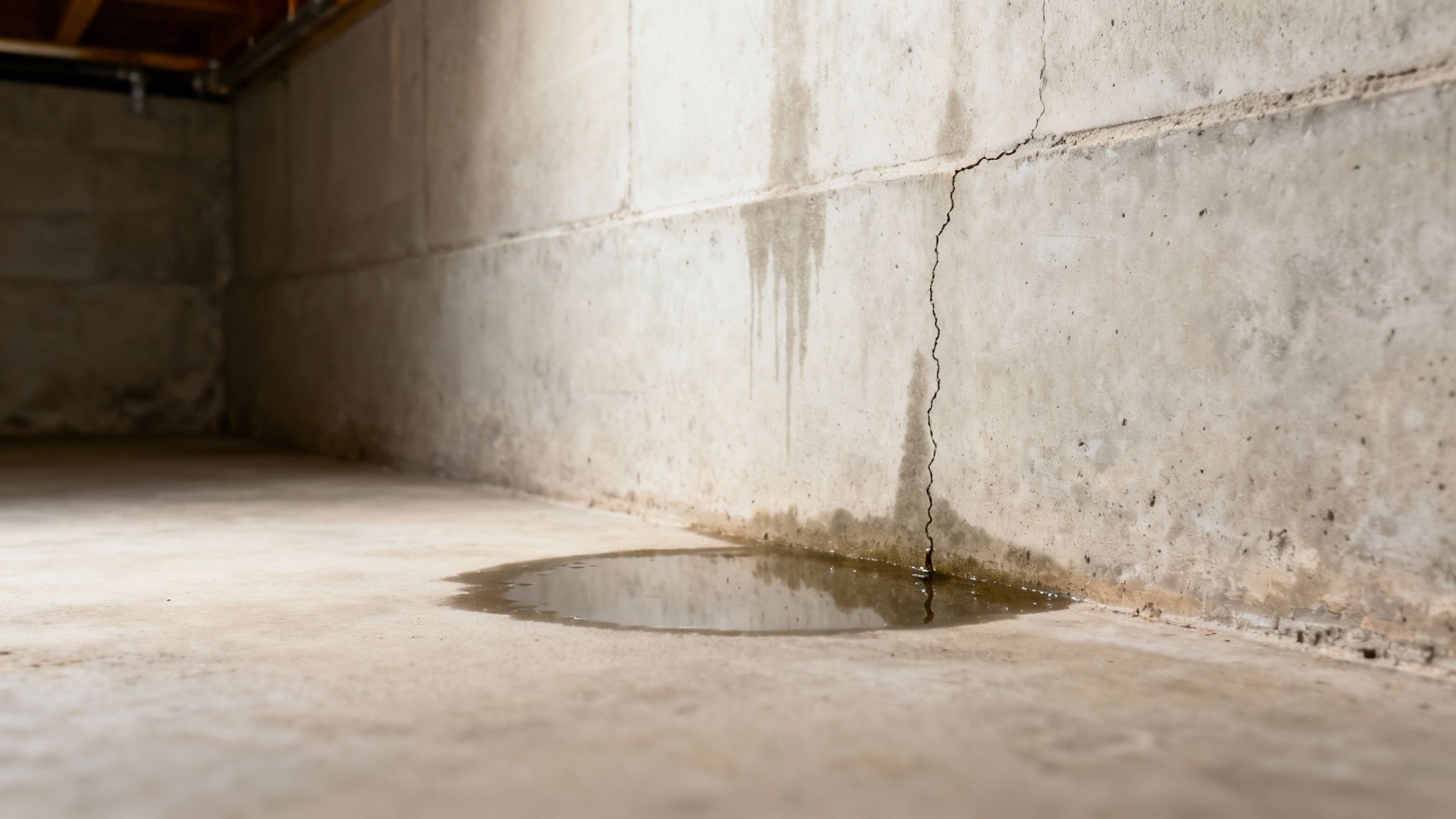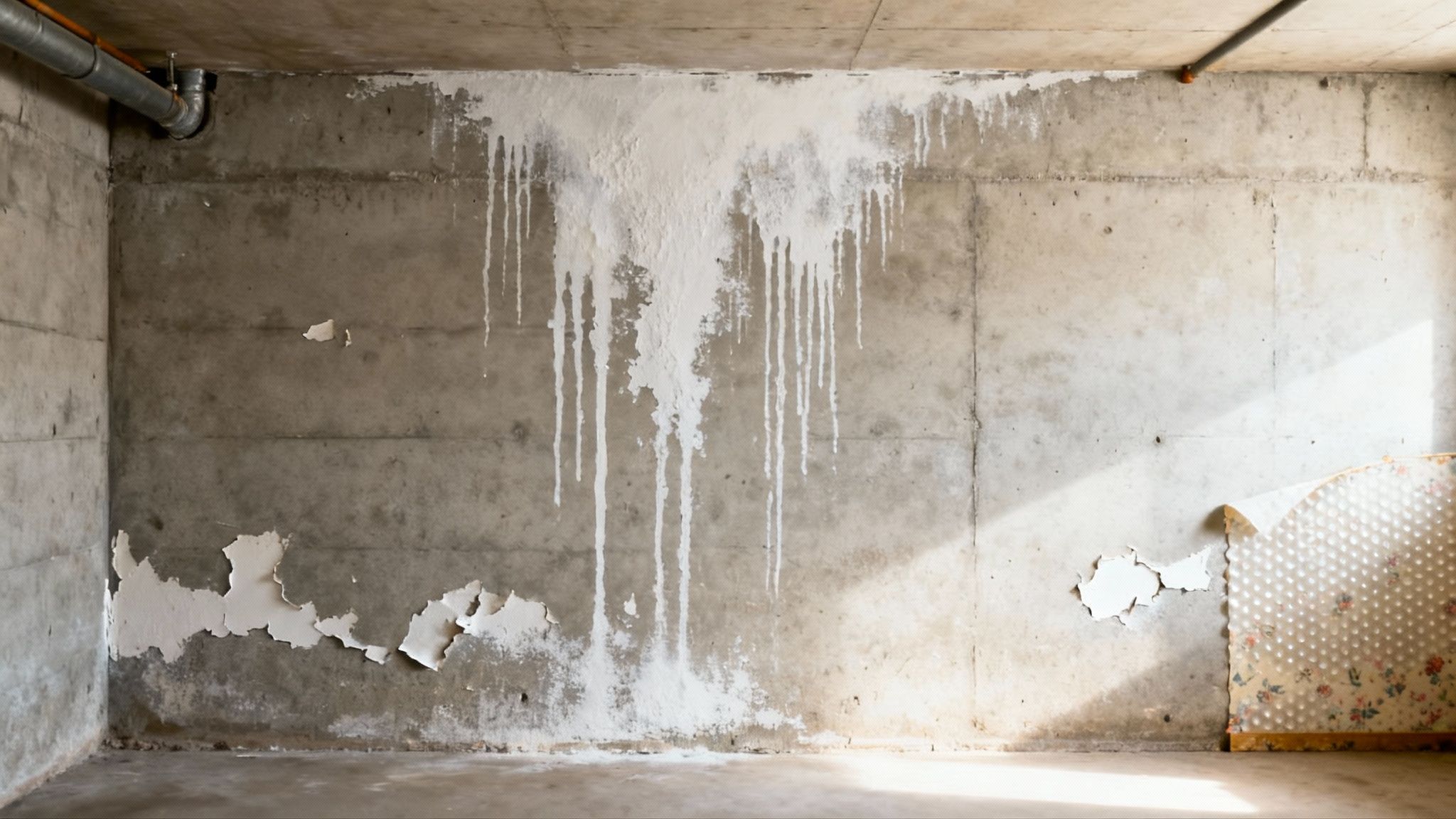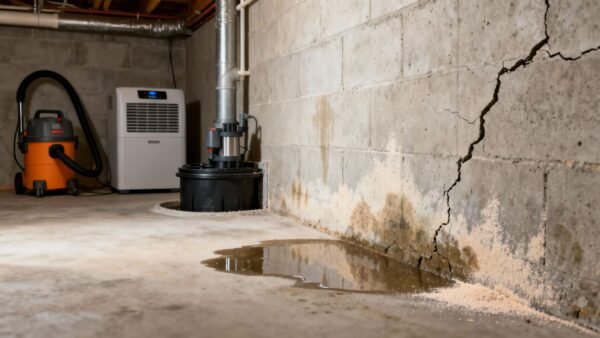That small puddle in the corner of your basement isn't just a nuisance—it's an alarm bell for your home’s health. Any amount of basement water damage needs your immediate attention, especially in Los Angeles where shifting soil and aging infrastructure can create unexpected problems. What starts small can spiral out of control, hitting your property’s value, structural integrity, and even the air you breathe.
Don't wait for a small leak to become a major disaster. The Onsite Pro team is ready 24/7 to provide a free assessment and expert guidance.
Get a Free Damage Assessment Now
Why a Small Leak Is a Big Problem in Los Angeles

Think of that tiny leak like a crack in a dam. It seems harmless at first, easy to ignore. But over time, the relentless pressure of water forces its way through, slowly but surely weakening your foundation until a major failure becomes a real possibility—a common concern for homes in hilly areas like the Hollywood Hills or older properties in Pasadena.
The Most Common Culprits Behind Basement Water Damage
Figuring out where the water is coming from is the first, most critical step to finding a permanent fix. Most basement water problems trace back to one of these three sources:
- Hydrostatic Pressure: This is the force of groundwater pushing against your foundation. After heavy Southern California rains, saturated soil exerts incredible pressure, forcing water through any tiny crack or joint it can find in the concrete.
- Poor Exterior Drainage: If your yard slopes toward the house or your gutters are clogged, rainwater from a sudden downpour has nowhere to go but down along your foundation. This pooling water is just waiting for a way inside.
- Plumbing Failures: It’s not always about the weather. A leaky water heater in a Sherman Oaks home, a burst pipe under the slab, or a backed-up sewer line can dump a massive amount of water into your basement in a very short time, causing immediate and widespread damage.
To help you connect the dots, here’s a quick rundown of the most frequent causes and what you should be looking for.
Common Causes and Initial Warning Signs
| Source of Water | Common Cause | Early Warning Sign |
|---|---|---|
| Groundwater Intrusion | High water table or saturated soil pushes on foundation walls. | Damp spots on walls, white chalky stains (efflorescence), peeling paint. |
| Exterior Drainage Issues | Clogged gutters or improper landscape grading around the house. | Puddles forming near the foundation after rain, water trickling in at the base of walls. |
| Cracks in Foundation | Concrete settling or hydrostatic pressure causing fractures. | Visible cracks (vertical or horizontal), musty smells, water seeping in after storms. |
| Plumbing Leaks | Burst supply lines, failing water heaters, or sewer backups. | Sudden puddles, sounds of dripping, an unexpected spike in your water bill. |
Spotting these signs early can make all the difference between a simple fix and a major restoration project.
Basement water issues are a surprisingly universal problem for homeowners. In fact, some studies show that an astonishing 98% of basements in the U.S. will experience water damage at some point. You can discover more insights about these waterproofing facts and see just how widespread the issue really is.
Ignoring these warnings doesn't just put your belongings at risk; it threatens the very framework of your home. Protecting your basement means you're safeguarding your entire property's structure and your financial investment.
Identifying the Hidden Signs of Water Damage

Most of the time, serious basement water damage doesn't announce itself with a sudden flood. It creeps in, leaving subtle clues that are all too easy to ignore. The key to preventing a costly disaster is to become a bit of a home detective and learn to spot these quiet signs before they get loud.
It's about going beyond obvious puddles and using your senses. That nagging, earthy smell that never seems to air out? That’s not just a "basement smell." It’s a dead giveaway for moisture buildup and potential mold growth, especially in coastal areas like Santa Monica where marine layer fog adds to ambient humidity. Your nose will often sniff out a problem long before your eyes can see it.
What to Look For on Your Walls and Floors
Your basement surfaces are telling a story about what’s happening behind them. You just have to know how to read it. Keep a sharp eye out for these changes, no matter how small they seem.
- Peeling Paint or Bubbling Wallpaper: When moisture works its way through concrete or drywall, it physically pushes the paint or paper off the surface. This causes it to bubble up, flake, or peel away—a classic indicator that the wall itself is saturated.
- Warped Wood: If you have wooden support beams, stairs, or baseboards, any sign of warping, swelling, or buckling is a major red flag. Wood is like a sponge; it soaks up moisture, expands, and starts to lose its strength.
- Efflorescence: This is the one that most homeowners miss. It looks like a white, chalky, or crystalline powder growing on your concrete or brick walls. Efflorescence is actually the mineral salts left behind after water seeps through the masonry and evaporates. It’s definitive proof that water is actively moving through your foundation.
Think of that musty odor as your basement's way of crying for help. It’s an undeniable indicator that a moisture problem exists, even if you can't see the source.
Interpreting the Signs Correctly
Each of these signs points to an underlying issue that needs to be fixed at the source. It’s tempting to just scrape off the efflorescence or paint over a water stain, but that’s like putting a bandage on a broken arm. You're hiding the symptom, not curing the problem.
To really get a handle on the situation, it helps to understand the full range of the most common signs of water damage throughout a home. Recognizing these early warnings is what empowers you to act decisively, protecting your property from the snowball effect of unchecked moisture.
The Unseen Risks of Ignoring Basement Moisture
Putting off dealing with basement moisture is a lot like ignoring the check engine light in your car. It’s easy to dismiss at first, but the problem underneath is only getting worse—and it can lead to a catastrophic breakdown. The consequences of that small damp spot can ripple through your entire home, hitting its structure, your family's health, and your wallet.
When moisture is left to linger, it wages a quiet war on your home’s foundation. Constant dampness slowly eats away at concrete, making it brittle and prone to cracking. Even worse, it rots the essential wooden support beams and floor joists holding your house up. What started as a minor nuisance can eventually compromise the very framework of your property.
Health Hazards Hiding in Plain Sight
Beyond the structural damage, the most immediate danger from basement water damage is to your health. A damp, dark basement is the perfect breeding ground for toxic mold and mildew.
These fungi aren't just ugly spots on the wall; they release microscopic spores into the air. Your HVAC system can then circulate them throughout your entire home. For many people, this triggers persistent allergies, asthma attacks, and other serious respiratory problems.
A chronically damp basement doesn't just damage your home—it contaminates the air you breathe every single day, turning your safe space into a source of illness.
The Financial Fallout of Neglect
Finally, ignoring the problem will inevitably hit you where it hurts: your finances. And the costs go way beyond the initial cleanup. Every single day, over 14,000 Americans face a water damage emergency. Think about this: just one inch of water in a basement can rack up damages exceeding $25,000. That shows you just how fast the costs can spiral out of control. You can learn more about these water damage statistics to see the full financial picture.
This number doesn't even factor in the significant drop in your property's value or the staggering expense of replacing ruined furniture, electronics, and irreplaceable family heirlooms. The small cost of addressing moisture early is nothing compared to the thousands you'll spend on remediation and replacement down the line.
Your First Steps After Discovering Water
That sinking feeling when you discover water pooling in your basement is something no homeowner wants. It’s easy to panic, but a calm, systematic approach is your best defense against long-term damage. The first move isn’t cleanup—it’s always safety.
Before you even think about wading in, head straight for your circuit breaker and shut off all electricity to the flooded area. Water and live circuits are a deadly mix, and this one step eliminates the immediate risk of electrocution.
Taking Control of the Situation
With the power off, your next mission is to stop the water at its source. If you can see a burst pipe or a leaking water heater, you’ll need to shut off your home’s main water valve. If the culprit is torrential rain overwhelming your drainage system, you may not be able to stop the flow right away.
Once the source is handled, it's time for the initial water removal. A good wet/dry vacuum is invaluable here. The goal is simple: get the standing water out as fast as you can. Every minute you wait gives moisture more time to soak into your home’s structure, and the clock is ticking on mold growth, which can start in as little as 24-48 hours.
After the bulk of the water is gone, the real work of drying begins.
- Create Airflow: Open up any basement windows and get fans running to circulate the air.
- Remove Moisture: Fire up any dehumidifiers you have to start pulling dampness out of the air, walls, and flooring.
- Move Belongings: Get any wet boxes, furniture, or other items to a dry, well-ventilated space where they can be properly assessed and dried.
These first steps are absolutely critical for damage control. But for major flooding or situations where the water might be contaminated, it’s important to understand what the pros do. Getting familiar with the emergency water cleanup process ensures your home is restored safely and completely, leaving no hidden moisture behind.
Knowing When to Call a Professional
While it's tempting to tackle a small puddle yourself, some basement water damage situations are way beyond a DIY fix. In fact, knowing when to put down the mop and pick up the phone is one of the most important decisions you can make. Getting it wrong can turn a manageable issue into a catastrophic, expensive nightmare for your home and health.
So, when is it time to bring in the pros? Deciding can be stressful in the moment, but this flowchart makes it simple.

Notice the first question isn't about the leak—it's about safety. If the situation looks hazardous, the decision is already made for you: call a professional immediately.
Key Triggers for Professional Help
If you run into any of these scenarios, it’s a clear signal to call an IICRC-certified restoration company right away:
- Standing Water Over One Inch: This much water is simply too deep for shop vacs and household tools. It points to a serious breach that requires commercial-grade pumps for proper extraction.
- Sewage Contamination: If the water came from a sewer backup, it's considered "black water." This is a biohazard filled with dangerous bacteria and pathogens that requires specialized equipment and strict cleanup protocols to handle safely.
- Moisture Lingering Over 48 Hours: Once water has been sitting for two days, the clock is ticking. The risk of widespread mold growth and permanent structural damage skyrockets. Professionals use tools like thermal imaging cameras to find every last pocket of hidden moisture before it's too late.
The global basement waterproofing market is on track to hit $25 billion by 2033, which shows just how seriously property owners are taking expert water mitigation. Before hiring anyone, make sure you understand key protections like their liability insurance for contractors. To see exactly how the experts get these tough jobs done, take a look at our detailed water damage restoration process.
Long-Term Solutions for a Permanently Dry Basement

Once you’ve wrestled an immediate water crisis under control, your focus has to shift. The real goal is making sure it never, ever happens again. Preventing future basement water damage isn’t about one magic fix; it’s about building a proactive, multi-layered defense system for your home’s foundation.
Think of it like putting a permanent raincoat on the lowest level of your house. This defense starts outside, right where the rain falls.
A permanently dry basement is an ongoing commitment, not a one-time fix. Consistent maintenance of both exterior and interior systems is the key to long-term success.
Fortifying Your Home's Exterior
The first and most effective line of defense is managing water before it even gets a chance to touch your foundation. You’d be surprised how much of a difference some simple landscaping and maintenance can make.
- Proper Grading: This is non-negotiable. The soil around your house absolutely must slope away from the foundation. It's a simple concept that uses gravity to your advantage, directing rainwater away instead of letting it pool up and push against your walls.
- Clean Gutters: Make sure your gutters and downspouts are clear of leaves and gunk. When gutters get clogged, water just spills over the side and saturates the ground right next to your foundation—exactly where you don't want it.
- Install French Drains: If you have stubborn water issues, a French drain is a game-changer. It's basically a gravel-filled trench with a perforated pipe that runs around the perimeter of your foundation to intercept groundwater and safely channel it away.
Reinforcing Your Basement's Interior
Even with a rock-solid exterior plan, adding a second layer of protection inside your basement is crucial for total peace of mind.
Start by meticulously sealing any cracks you can see in the foundation walls or floor. A high-quality epoxy or polyurethane sealant works wonders. After that, think about applying a waterproof coating or membrane directly to the interior walls. This acts as a final barrier, blocking any moisture that might try to seep through the porous concrete.
For a truly robust system, installing a sump pump is essential. It’s your basement’s personal bodyguard, actively pumping out any water that collects in its basin before it has a chance to flood.
Pairing the sump pump with a powerful dehumidifier is the final piece of the puzzle. It manages the ambient moisture in the air, which is a critical step in preventing mold growth. Our guide to professional basement dehumidification breaks down just how important controlling humidity is.
Keeping your basement dry for good isn't just about removing water. It's also about understanding how to avoid mold in your home and damp buildings so you don't trade one problem for another.
Answering Your Questions About Basement Water Damage
When you find water in your basement, the questions start flooding in right along with it. It's a stressful situation, but getting clear, straightforward answers can help you take control. We’ve tackled some of the most common questions homeowners have right here.
Does Homeowner's Insurance Cover Basement Water Damage?
This is usually the first question on everyone's mind, and the answer is… it depends. The key is how the water got there. A standard homeowner's policy is designed for sudden and accidental events—think a washing machine hose that bursts or a water heater that suddenly fails.
But they almost always exclude damage from gradual issues. A slow, seeping crack in the foundation, poor maintenance, or natural overland flooding from a heavy storm won't be covered. For rising rivers or storm surges, you'll need a separate flood insurance policy from FEMA's National Flood Insurance Program (NFIP). The fine print really matters here; you can learn more about how homeowner's insurance covers water damage in our detailed guide.
How Quickly Does Mold Grow After Water Damage?
Faster than you think. Once moisture shows up, the clock is ticking. In the dark, damp environment of a basement, mold can start to grow in as little as 24 to 48 hours. All it needs is a little water and a food source like drywall, wood, or even dust. This is why immediate professional drying is so critical in humid climates.
This is why you'll hear professionals talk so much about rapid response. That incredibly narrow window is your best chance to dry everything out before a simple water issue becomes a major mold problem that tanks your home's air quality.
What Is the Difference Between Waterproofing and Damp Proofing?
While they sound similar, these two solutions offer very different levels of protection. It’s like the difference between a water-resistant jacket and a full-on waterproof rain slicker.
- Damp Proofing: Think of this as a basic moisture barrier. It’s typically a black, asphalt-based coating applied to the outside of a foundation to block moisture from the soil. It’s good for preventing general dampness but won’t stop liquid water that's under pressure.
- Waterproofing: This is a comprehensive system designed to create a completely sealed barrier. It often involves thick membranes, interior and exterior drainage systems, and sump pumps to actively manage and remove water, keeping your basement truly dry.
Can I Sell a House with Past Basement Water Damage?
Yes, you can, but honesty is the only policy. In California, you are legally required to disclose any known water damage to potential buyers. Trying to hide it is a recipe for legal and financial disaster.
The best way forward is to have the damage professionally repaired and keep every single piece of documentation. A basement that was once a liability can actually become a selling point if you can show buyers the receipts and warranties for a top-notch waterproofing job. It gives them peace of mind knowing the problem was handled correctly.
If your basement has water intrusion, waiting only makes things worse. The IICRC-certified team at Onsite Pro Restoration is ready 24/7 to give you a free assessment and get your home back to normal, fast. Contact us now to get started.





